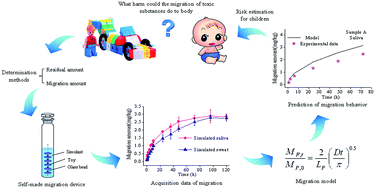A novel method to investigate the migration regularity of toxic substances from toys to saliva and sweat†
Abstract
Residual toxic substances found in toys are a serious threat to children's health; these substances may migrate into the body when toys are handled or sucked by children. However, the migration risk caused by toxic toys is difficult to estimate if the migration regularity of these substances is unknown. In this study, a method was established to investigate the migration regularity of toxic substances, specifically styrene, from acrylonitrile–butadiene–styrene toys to saliva and sweat. Two determination methods of the residual amount and migration amount were initially developed and then utilized to obtain specific migration data by using a self-made migration device. Migration models were established according to Fick's second law; the models included a diffusion coefficient and a partition coefficient calculated on the basis of the obtained migration data. These models were then applied to predict the migration behavior of styrene in real toys; afterward, predicted findings were subsequently compared with experimental data. The experimental data were consistent with the predicted findings and thus verified the validity of the migration models. Using this approach, we can determine the migration regularity of other toxic substances in toys; the predictability of the risk caused by toxic toys is also a relevant factor to promote toy safety.


 Please wait while we load your content...
Please wait while we load your content...